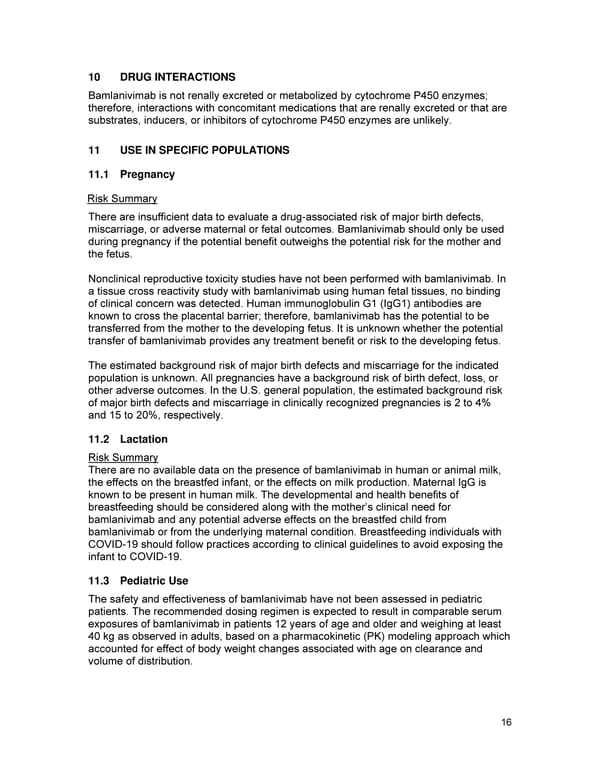10 DRUG INTERACTIONS Bamlanivimab is not renally excreted or metabolized by cytochrome P450 enzymes; therefore, interactions with concomitant medications that are renally excreted or that are substrates, inducers, or inhibitors of cytochrome P450 enzymes are unlikely. 11 USE IN SPECIFIC POPULATIONS 11.1 Pregnancy Risk Summary There are insufficient data to evaluate a drug-associated risk of major birth defects, miscarriage, or adverse maternal or fetal outcomes. Bamlanivimab should only be used during pregnancy if the potential benefit outweighs the potential risk for the mother and the fetus. Nonclinical reproductive toxicity studies have not been performed with bamlanivimab. In a tissue cross reactivity study with bamlanivimab using human fetal tissues, no binding of clinical concern was detected. Human immunoglobulin G1 (IgG1) antibodies are known to cross the placental barrier; therefore, bamlanivimab has the potential to be transferred from the mother to the developing fetus. It is unknown whether the potential transfer of bamlanivimab provides any treatment benefit or risk to the developing fetus. The estimated background risk of major birth defects and miscarriage for the indicated population is unknown. All pregnancies have a background risk of birth defect, loss, or other adverse outcomes. In the U.S. general population, the estimated background risk of major birth defects and miscarriage in clinically recognized pregnancies is 2 to 4% and 15 to 20%, respectively. 11.2 Lactation Risk Summary There are no available data on the presence of bamlanivimab in human or animal milk, the effects on the breastfed infant, or the effects on milk production. Maternal IgG is known to be present in human milk. The developmental and health benefits of breastfeeding should be considered along with the mother’s clinical need for bamlanivimab and any potential adverse effects on the breastfed child from bamlanivimab or from the underlying maternal condition. Breastfeeding individuals with COVID-19 should follow practices according to clinical guidelines to avoid exposing the infant to COVID-19. 11.3 Pediatric Use The safety and effectiveness of bamlanivimab have not been assessed in pediatric patients. The recommended dosing regimen is expected to result in comparable serum exposures of bamlanivimab in patients 12 years of age and older and weighing at least 40 kg as observed in adults, based on a pharmacokinetic (PK) modeling approach which accounted for effect of body weight changes associated with age on clearance and volume of distribution. 16
 Fact Sheet for Health Care Providers Page 15 Page 17
Fact Sheet for Health Care Providers Page 15 Page 17